Once again, an annual ritual had arrived – the building of sea turtle hatcheries, sized for loggerhead turtle hatchlings, on Cape Island. I accompanied a mixed crew of US Fish and Wildlife staff and volunteers led by the manager of Cape Romain National Wildlife Refuge, Sarah Dawsey, on the “Pacman” through the marshes and bays of Cape Romain to Cape Island. Pacman is a craft without seats designed to carry loads like ATV’s and trailers, the means of transporting us and our gear to the site of the hatcheries. We had a fine morning heading out Jeremy Creek, across Muddy Bay, along Horsehead Creek, and finally across Cape Romain Harbor to Cowpen Point on the back side of Cape Island. (See Map). Pacman also has a front door operated by winch that allows the payloads to be unloaded. 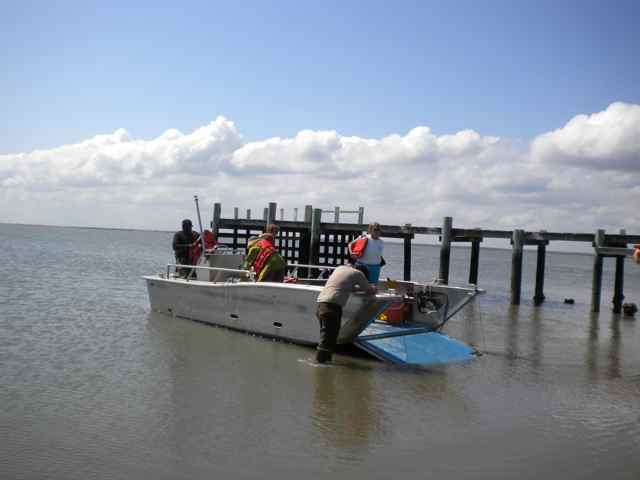 With the dock to Cape Island still unusable by the destruction from Hurricane Irene, we were the payload to go out the door and wade to the beach with our tools and supplies – an amphibious landing of sorts.
With the dock to Cape Island still unusable by the destruction from Hurricane Irene, we were the payload to go out the door and wade to the beach with our tools and supplies – an amphibious landing of sorts.
I recalled last year during the building of loggerhead turtle hatcheries, viewing the narrow middle of the island, and thinking (my words from one year ago) “So fragile, so seemingly inadequate for storm waves, and the waves of nesting turtles coming this spring and summer.” Unfortunately the words were prophetic with the havoc wreaked on the island by Hurricane Irene which I described in Flattening of an Island. There was hope that the three breaches (breaks in the island – new inlets) would close over the winter, and the island would be whole again. This was not to be, and these pieces were now the Cape Islands. 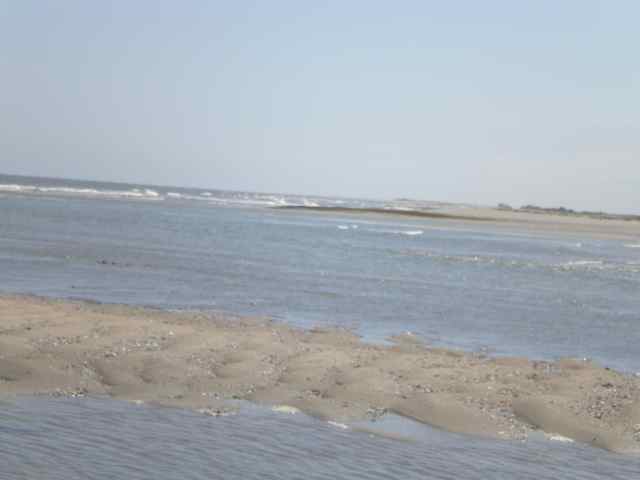 We would travel north and not see those breaches on the first day; the only suitable area with sufficient elevation for the hatcheries was to the north.
We would travel north and not see those breaches on the first day; the only suitable area with sufficient elevation for the hatcheries was to the north.
We had a large and seasoned crew, and we accomplished much work on the first day. We built seven hatcheries, though further work would be needed to complete these structures.  Before lunch we had a little surprise.
Before lunch we had a little surprise. 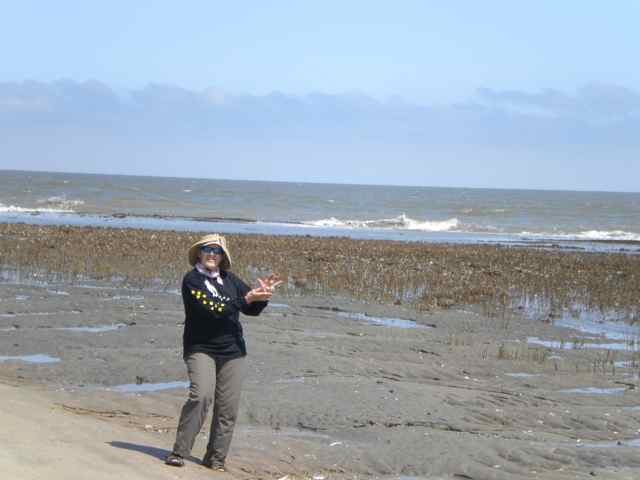 Lucy Maxwell, a retired school teacher, Birds of Prey volunteer, and a veteran hatchery builder, was preparing to pick up her outer white shirt she had removed during the warm morning. A black object with legs stood out on the white, and we came together to take a look at this black widow spider.
Lucy Maxwell, a retired school teacher, Birds of Prey volunteer, and a veteran hatchery builder, was preparing to pick up her outer white shirt she had removed during the warm morning. A black object with legs stood out on the white, and we came together to take a look at this black widow spider. 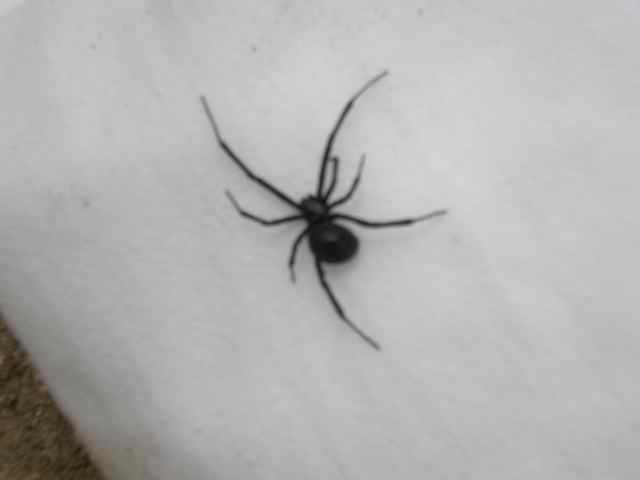 I had heard for years that there was a sizable population of these arachnids on the island (along with hordes of biting insects, water moccasins, patrolling sharks – all a marketing ploy). This spider was the real deal, and after a fuzzy photo I tried to get another shot of the classic hourglass. The spider was not interested in posing, and instead slipped down into one of the sleeves. Sarah Dawsey finally extricated the spider from the shirt, and removed it unscathed to the dunes.
I had heard for years that there was a sizable population of these arachnids on the island (along with hordes of biting insects, water moccasins, patrolling sharks – all a marketing ploy). This spider was the real deal, and after a fuzzy photo I tried to get another shot of the classic hourglass. The spider was not interested in posing, and instead slipped down into one of the sleeves. Sarah Dawsey finally extricated the spider from the shirt, and removed it unscathed to the dunes.
As usual, at lunch we hung out by the ATV’s on the beach, bantered, and looked for loggerheads outside of the small surf. 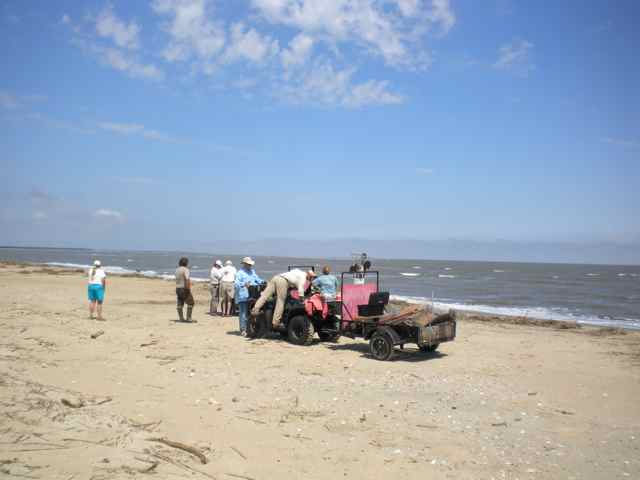 We were not successful – no Greeting from these marine reptiles. We also wondered if the first nest might come earlier this year due to the minimal winter we had experienced. After we returned to work, Sarah Dawsey and another USFWS staff and former intern Melissa Bimbi went south to survey the breaches at low tide, and hopefully formulate a plan for how the nest finding and relocation would take place to the south. They found all of the breaches required wading across, and the depth of one was up above the waist. We had brought a kayak on Pacman, and that craft would have to be used for all the breach crossings. Additionally, a dolly would be needed to haul the kayak over each of the separated Cape isles to the next breach, and so on. This was a logistical nightmare, but not unknown to the loggerhead program on Cape Island. I imagined that Sarah had been turning this puzzle over in her head (both waking and non-waking hours) since last fall.
We were not successful – no Greeting from these marine reptiles. We also wondered if the first nest might come earlier this year due to the minimal winter we had experienced. After we returned to work, Sarah Dawsey and another USFWS staff and former intern Melissa Bimbi went south to survey the breaches at low tide, and hopefully formulate a plan for how the nest finding and relocation would take place to the south. They found all of the breaches required wading across, and the depth of one was up above the waist. We had brought a kayak on Pacman, and that craft would have to be used for all the breach crossings. Additionally, a dolly would be needed to haul the kayak over each of the separated Cape isles to the next breach, and so on. This was a logistical nightmare, but not unknown to the loggerhead program on Cape Island. I imagined that Sarah had been turning this puzzle over in her head (both waking and non-waking hours) since last fall.
Another threat has appeared to the nesting populations on the island, including shorebirds. Minks have now become a regular destroyer of nests on the island. Thie new threat, also mammal, appeared as tracks on the island – doglike prints. Yet there were no human prints along with those tracks. Both Sarah Dawsey and Jerry Tupacz believed the tracks to be those of a coyote. How would this mammal have gotten to Cape? Most likely from Murphy Island, just across the inlet from the north point of Cape Island. They are known to be fond of digging out the nests and eating the loggerhead eggs further north on the beaches of Santee Coastal Reserve, and Yawkey Wildlife Preserve.
On our way back to the dock and Pacman, we stopped to view two dead reptiles. The three foot alligator most likely washed out the north inlet – the extension of Alligator Creek. The other stranding was not so common – a Kemp’s Ridley sea turtle. 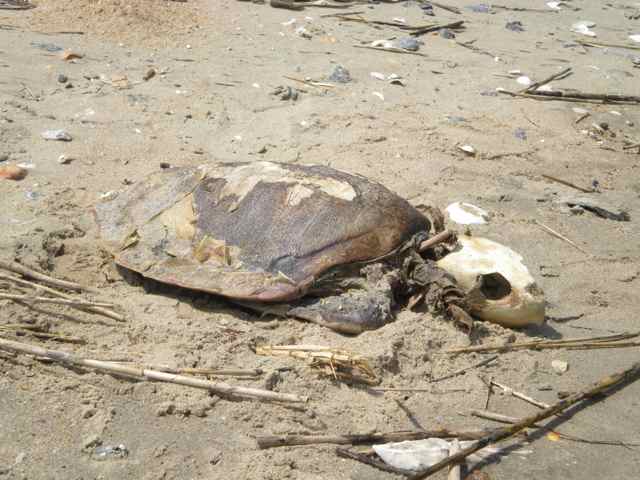 According to our biologists, it was not quite full size, which would still be considerably smaller than a mature loggerhead. It would count as one of the twenty sea turtle strandings to date in SC. The species is the most critically endangered of the sea turtles. Their nesting takes place almost exclusively on a beach in Rancho Nuevo on the Gulf Coast of Mexico.
According to our biologists, it was not quite full size, which would still be considerably smaller than a mature loggerhead. It would count as one of the twenty sea turtle strandings to date in SC. The species is the most critically endangered of the sea turtles. Their nesting takes place almost exclusively on a beach in Rancho Nuevo on the Gulf Coast of Mexico.
I returned to the island on Friday, missing a day when my peers were wet, cold, and welcomed to the landing by innumerable no-seeums’s. Jerry Tupacz led the group for the second day, starting his seasonal work with the program. Our work this day finished up a small hatchery bringing the total to nine, and the combined capacity to four hundred nests. While we completed attaching hardware cloth to the sides, the chicken wire for the tops was replaced. 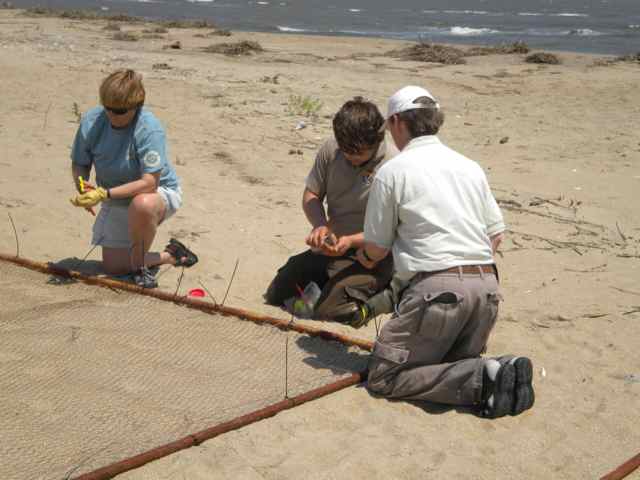 We looked again in vain at lunch for loggerheads.
We looked again in vain at lunch for loggerheads. 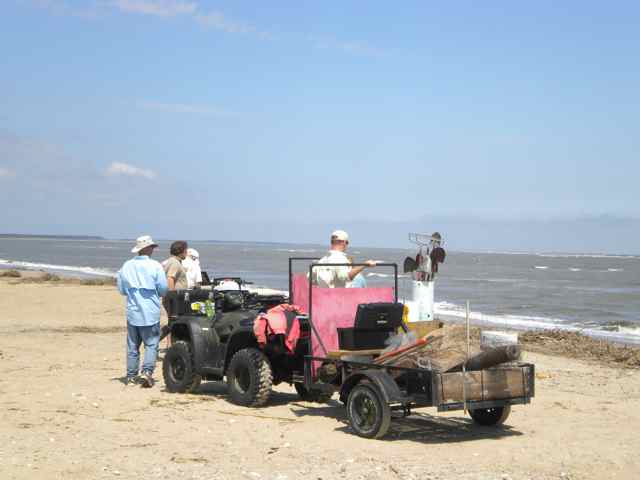 On the previous day, Wayne Tucker, while waiting at the dock on Pacman, did have a sighting.
On the previous day, Wayne Tucker, while waiting at the dock on Pacman, did have a sighting.
We took the opportunity before leaving the island to take a look at the first breach to the south, less than a mile past the ATV path across the island to Cowpen Point. The inlet was wider and more substantial than I imagined. 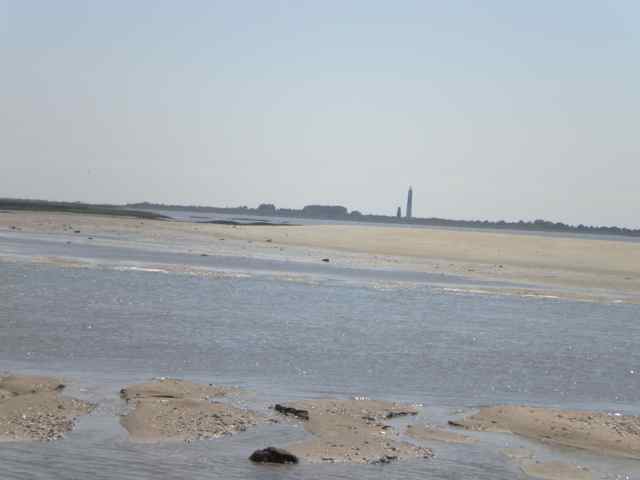 I could see where much of the sand had gone – large sandbars were distributed around the sound side of the breach. The rearrangement of this barrier island, with this breach representing its dynamic nature, was striking and beautiful. The dilemma for the loggerhead program was where would all the nests go? About a mile and a half of beach had disappeared, and the flattened nature of much of the island does not provide viable nesting territory. And how would the returning nesting turtles deal with this deficit – more false crawls? More nests on Lighthouse Island? This will be a most interesting season on the Cape Islands.
I could see where much of the sand had gone – large sandbars were distributed around the sound side of the breach. The rearrangement of this barrier island, with this breach representing its dynamic nature, was striking and beautiful. The dilemma for the loggerhead program was where would all the nests go? About a mile and a half of beach had disappeared, and the flattened nature of much of the island does not provide viable nesting territory. And how would the returning nesting turtles deal with this deficit – more false crawls? More nests on Lighthouse Island? This will be a most interesting season on the Cape Islands.
Many other questions have been posed by a fascinating Genetics study. Some interesting results have come to light already through the identification of nesting turtles. This study will continue, and it has started already – the first nest was found on April 30, on the most southern of the Cape isles. According to refuge staff, this is the first ever recorded nest on the refuge in April. It should be quite a season.
Nature finds a way to survive. I wish the Loggerheads well!
This will be a challenging year for the tutrles AND their stewards!